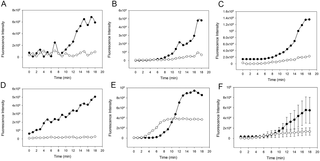PLOS ONE ( IF 2.9 ) Pub Date : 2018-01-11 , DOI: 10.1371/journal.pone.0191292 Lorenz Jenny , József Dobó , Péter Gál , Gábor Pál , Wilbur A. Lam , Verena Schroeder

|
The complement and coagulation systems closely interact with each other. These interactions are believed to contribute to the proinflammatory and prothrombotic environment involved in the development of thrombotic complications in many diseases. Complement MASP-1 (mannan-binding lectin-associated serine protease-1) activates coagulation factors and promotes clot formation. However, this was mainly shown in purified or plasma-based static systems. Here we describe the role of MASP-1 and complement activation in fibrin clot formation in a microvascular, whole blood flow model. This microfluidic system simulates blood flow through microvessels at physiological flow and shear rates and represents the closest model system to human physiology so far. It features parallel microchannels cultured with endothelial cells in a transparent microfluidic chip allowing real-time evaluation of clot formation by confocal microscopy. To test their effects on clot formation, we added the following activators or inhibitors (individually or in combination) to whole blood and performed perfusion experiments: rMASP-1cf (recombinant active form of MASP-1), complement activator zymosan, selective MASP-1 inhibitor SGMI-1 (based on the Schistocerca gregaria protease inhibitor scaffold), classical pathway inhibitor rSALO (recombinant salivary anti-complement from Lutzomyia longipalpis). Addition of rMASP-1cf resulted in accelerated fibrin clot formation while addition of SGMI-1 delayed it. Complement activation by zymosan led to increased clot formation and this effect was partially reversed by addition of rSALO and almost abolished in combination with SGMI-1. We show for the first time a strong influence of MASP-1, complement activation and pathway-specific inhibition on coagulation in a microvascular flow system that is closest to human physiology, further underpinning the in vivo relevance of coagulation and complement interactions.
中文翻译:

补体系统的MASP-1增强了微血管全血流模型中的血凝块形成
补体和凝血系统彼此紧密相互作用。据信这些相互作用促成参与许多疾病中血栓形成并发症的促炎和血栓形成环境。补体MASP-1(甘露聚糖结合凝集素相关的丝氨酸蛋白酶-1)激活凝血因子并促进血凝块形成。但是,这主要显示在纯化的或基于等离子体的静态系统中。在这里,我们描述了微血管,全血流模型中MASP-1和补体激活在纤维蛋白凝块形成中的作用。该微流体系统以生理流动和剪切速率模拟通过微血管的血液流动,并代表了迄今为止最接近人类生理的模型系统。它具有在透明微流控芯片中与内皮细胞一起培养的平行微通道,可通过共聚焦显微镜实时评估血凝块形成。为了测试其对血凝块形成的影响,我们向全血中添加了以下激活剂或抑制剂(单独或组合使用)并进行了灌注实验:rMASP-1cf(MASP-1的重组活性形式),补体激活物zymosan,选择性MASP-1抑制剂SGMI-1(基于格氏血吸虫(Schistocerca gregaria)蛋白酶抑制剂支架),经典途径抑制剂rSALO(来自Lutzomyia longipalpis的重组唾液抗补体)。添加rMASP-1cf导致加速的血纤蛋白凝块形成,而添加SGMI-1则延迟了血凝块的形成。酵母聚糖对补体的激活导致血凝块形成的增加,并且通过添加rSALO可以部分逆转这种作用,与SGMI-1结合几乎可以消除这种作用。我们首次展示了MASP-1,补体激活和通路特异性抑制对最接近人类生理学的微血管流动系统中凝血的强烈影响,进一步巩固了体内凝血和补体相互作用的相关性。











































 京公网安备 11010802027423号
京公网安备 11010802027423号